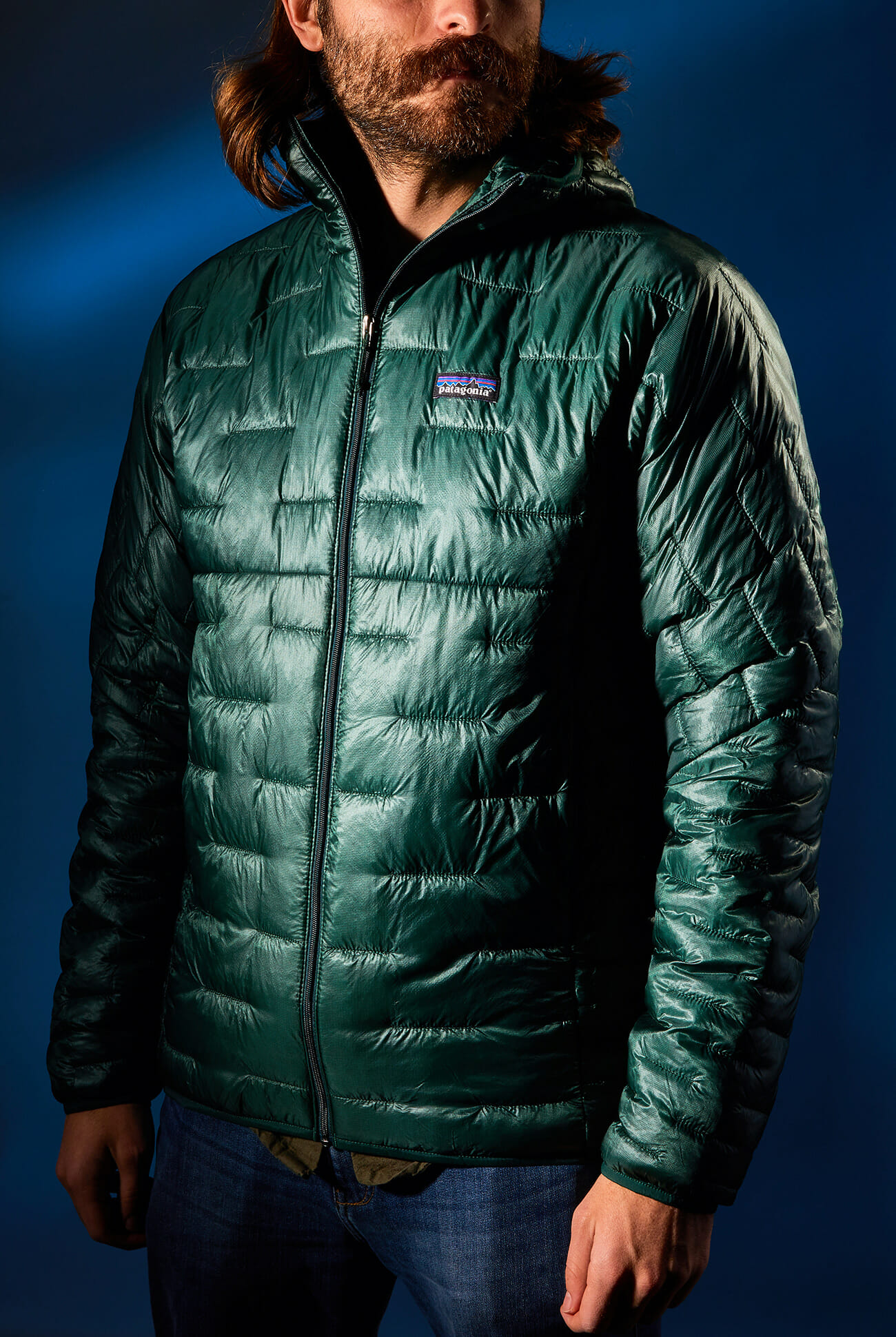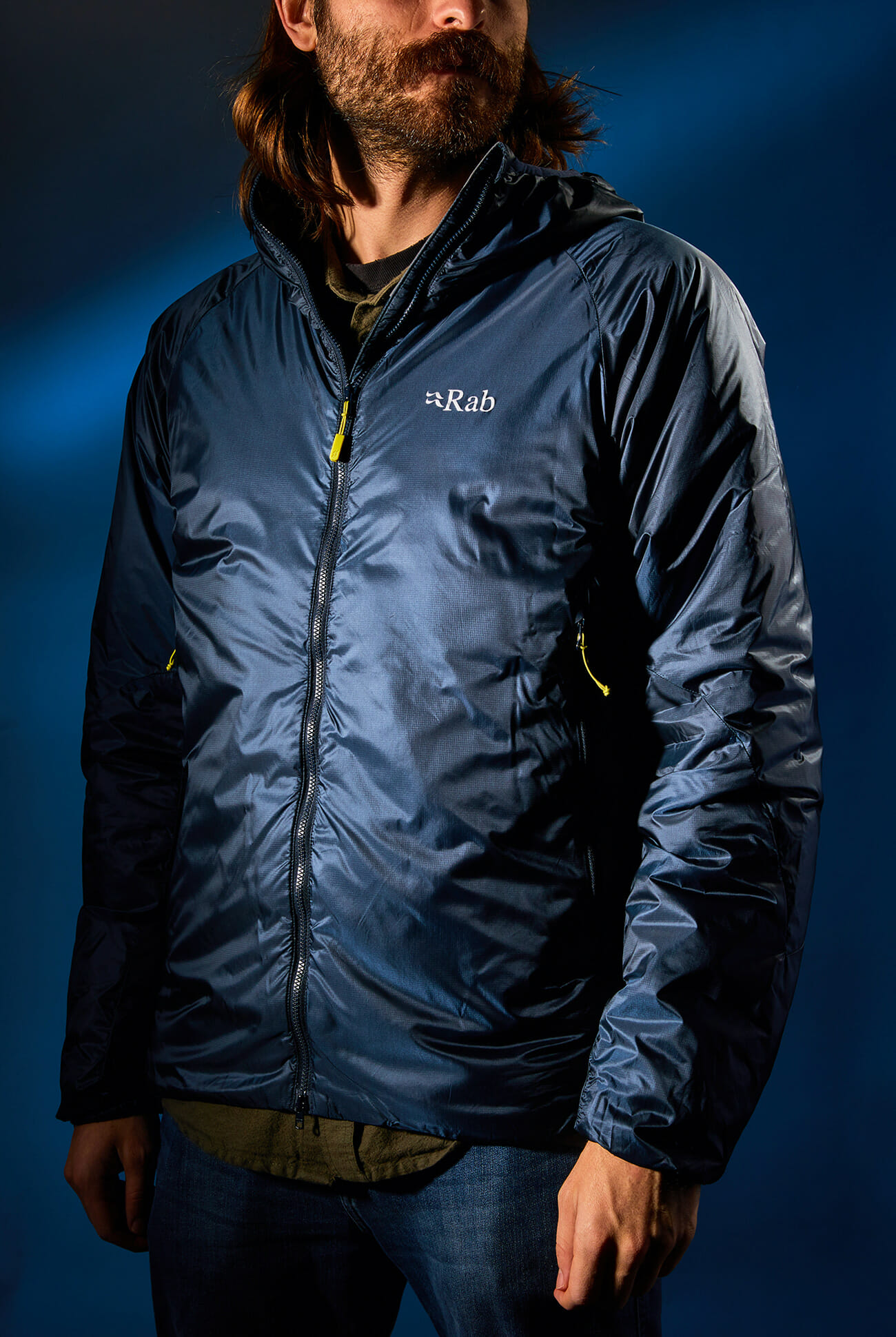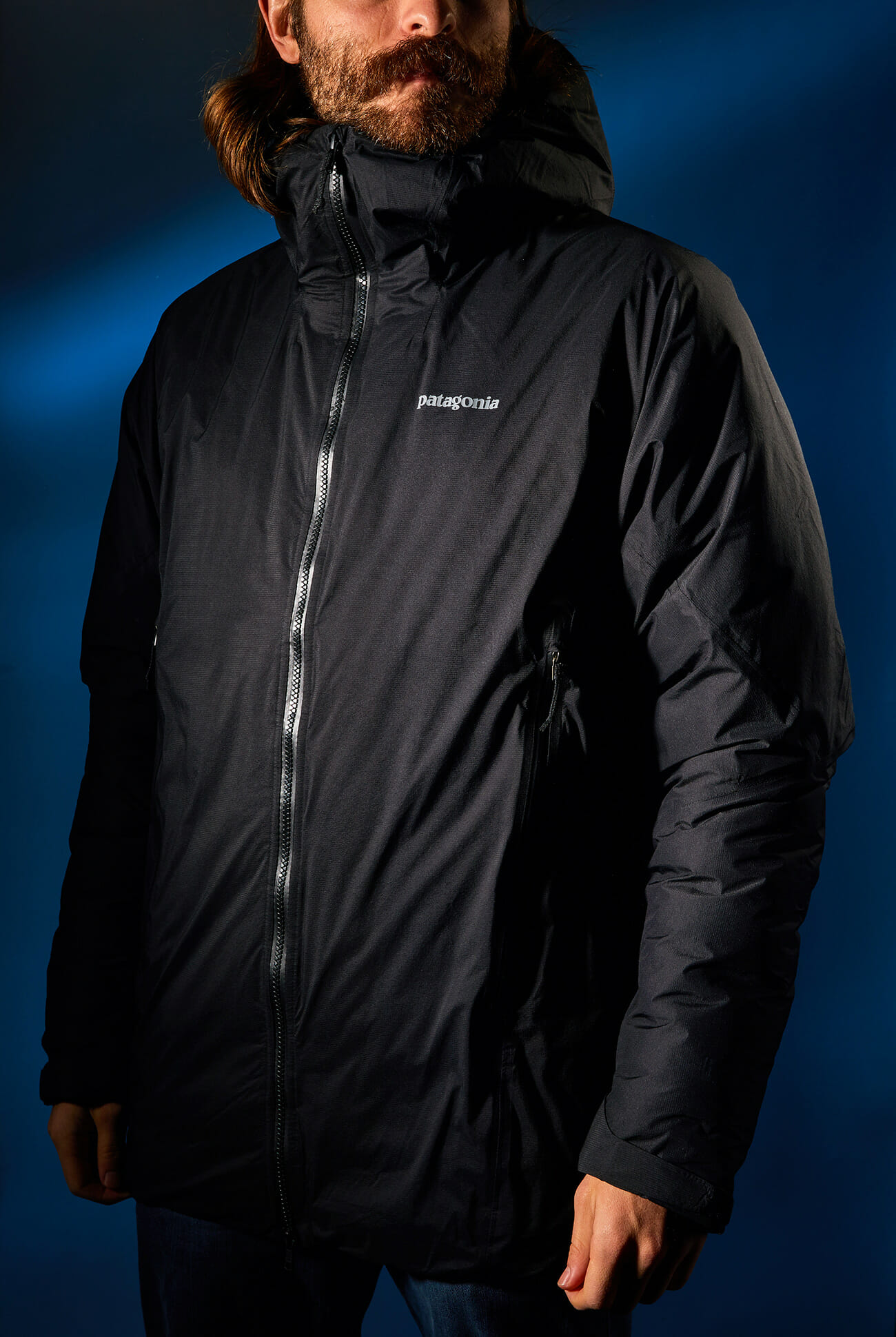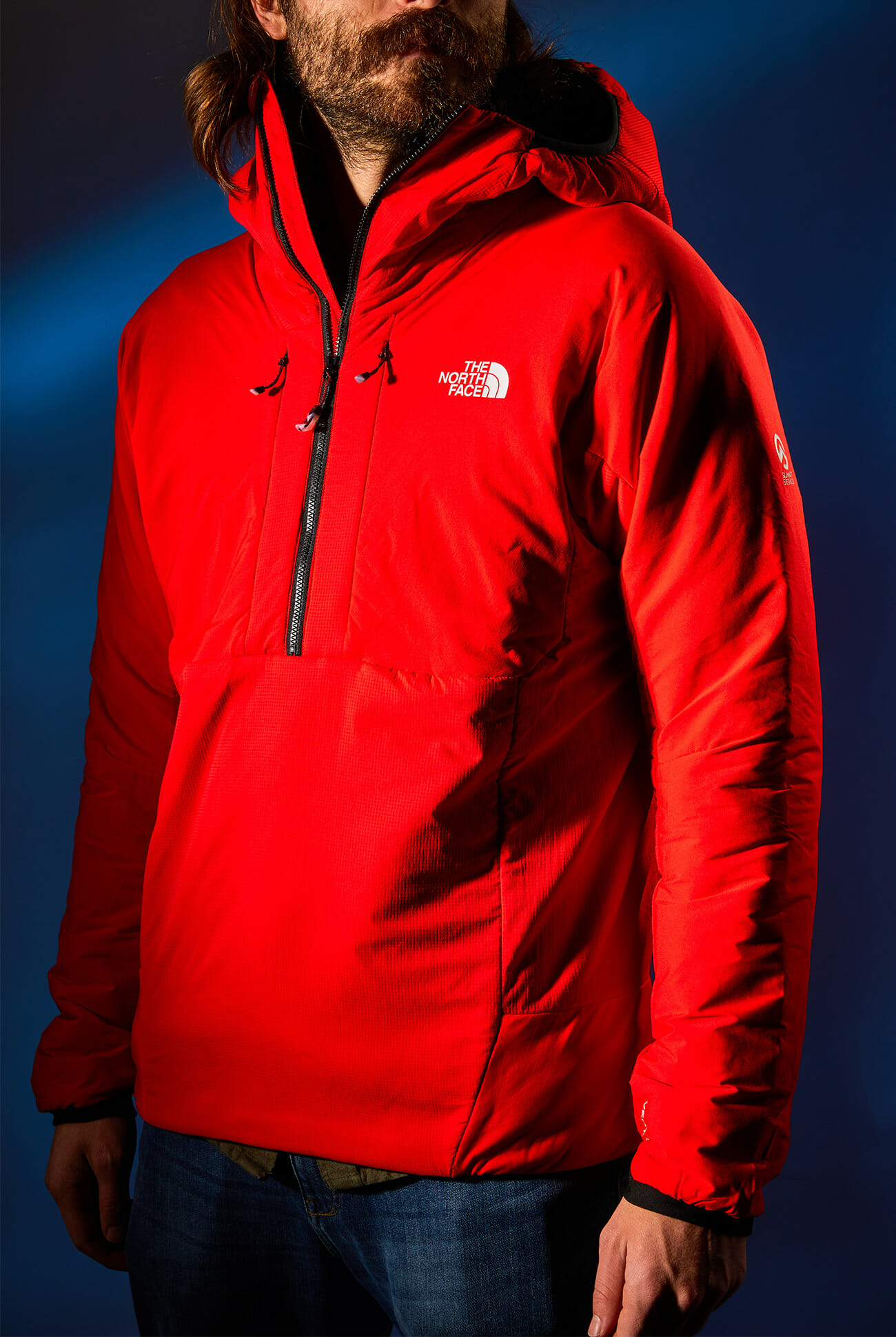Last Updated January, 2019: We’ve updated our guide of the best synthetic down jackets with the 10 best picks for Winter 2019. Prices and links have also been updated. You can view last year’s best synthetic down jackets on page two.
Editor’s Choice: Patagonia Micro Puff Hoody

Patagonia released the Micro Puff last year, and it’s maintaining its spot as our pick for the best synthetic down jacket of the year. The jacket beats out the others across multiple levels — it’s the lightest jacket on this list but still maintains plenty of warmth, and does so without sacrificing the features that make for a great everyday jacket too, like zippered hand pockets and interior organization with two mesh sleeves.
The only potential downside to the Micro Puff is price, but it still isn’t the most expensive jacket that we’ve come across and the benefits that it provides meet that additional value in our eyes. The key to the jacket’s success is PlumaFill, proprietary insulation that Patagonia has developed that sets a high benchmark for other companies seeking to create warmer and lighter materials. There may be other jackets better suited for specific use cases and needs — they’re likely on this list — but the Micro Puff is the most versatile synthetic down jacket we’ve encountered, and for that, it’s our Editor’s Pick.
Weight: 9.3 ounces
Fill Material: 65-g PlumaFill, 100% polyester
Shell Material: Nylon ripstop Pertex Quantum
Waterproofing: DWR finish
Introduction
Synthetic down has traditionally been regarded as a cheaper, less effective alternative to the real thing, but thanks to advances in technology, synthetics have come into their own, rivaling goose down in many areas and even surpassing it in durability and water resistance. Technologies like Polartec’s Alpha fiber, developed for military use, or Columbia’s proprietary TurboDown, a mix of synthetic materials and goose down, are finding their way into a wider range of products. The result of all this innovation is that consumers in 2018 have access to synthetic jackets that are warmer, better ventilated, lighter and more durable than ever. The fake stuff is here to stay, and that’s a good thing.
Additional contribution by AJ Powell.
What to Know Before You Buy a Synthetic Down Jacket
Down vs. Synthetic
A great insulating piece, be it a jacket or a sleeping bag, is warm, lightweight and packable. Both down and synthetic-filled products offer these qualities, but each has its pros and cons.
Down is found in layers underneath the rougher exterior feathers of ducks and geese — it’s what keeps them warm while floating around all winter, so, naturally, it will keep us warm too. Despite that, moisture is the undoing of down, causing it to clump up and lose its heat-retaining qualities. It also should be noted that while large-scale efforts have been made by big brands such as Patagonia and The North Face, not all down is ethically sourced, and animal cruelty does happen.
Synthetic insulation is man’s attempt to copy down with polyester fibers arranged in different sizes that cluster and trap heat much like real feathers. The artificial version gets the job done and maintains packability and a low weight — plus it’s hypoallergenic. The polyester fibers that make up synthetic products have a higher weight-to-warmth ratio, so they tend to be a bit bulkier. Synthetic does have the benefit of being much more water resistant though; it doesn’t clump when wet like down and it dries much quicker.
As far as labeling is concerned, natural down will always be labeled “down.” You may encounter a fancy first prefix, which usually refers to proprietary waterproofing treatments applied to down, such as Q.Shield by Mountain Hardwear. It should be noted that while the industry is getting better at making down resistant to moisture, no feathers are truly waterproof. Synthetic insulation will also carry proprietary names such as PrimaLoft.
Not sure which to choose? Down is great for cold and dry environments but tends to be more expensive. Take synthetic if there’s a chance it’ll get wet, or if you’re just looking for a break on the price.
Active Insulation
Until Patagonia released its Nano Air Jacket in 2014, active insulation flew below the radar (the concept was first introduced by Polartec in late 2012). Now there are enough companies making apparel that’s both warm and breathable that active insulation can officially be considered as its own category.
Technically, active insulation is a type of synthetic insulation, (a water-resistant alternative to down), but because of some fundamental differences that make it unique, active should be considered on its own. The technology draws its name from its intended use — active insulation garments are insulating pieces that are meant to be worn during activity (unlike, for example, a down jacket one might throw on after activity, once the body starts to cool down).
Every active piece has one feature in common: they’re incredibly breathable. How this is achieved depends on the insulation used in the jacket, and every company uses a different version. Some are proprietary, like Patagonia’s FullRange insulation, and some, such as Polartec’s Alpha insulation, which was originally developed for the US Special Forces, are sourced by a range of companies.
As with other types of synthetic insulation, active insulation is highly water-resistant and compressible. In comparison to regular synthetic insulation, active is the most breathable form of synthetic insulation available today thanks to a construction that prevents the migration of fibers within the piece while allowing for extra stretch and superior moisture management. Many active pieces are designed with an exterior shell that’s also more breathable but is often softer and less water-repellent than what’s found in other synthetic apparel.
All active insulation, no matter the brand, is designed to prevent lots of layer swaps so that it can be worn throughout the entirety of an activity like hiking, climbing or skiing.
The 10 Best Synthetic Jackets of 2018
Best Do-It-All Jacket: Arc’teryx Atom LT
The Atom LT is made with breathable Coreloft insulation, which functions better than down when placed under a shell. Combined with a hydrophobic finish, it does a lot to keep the wearer from getting damp from either weather or exertion. Polartec stretch side panels keep the LT flexible. It’s lighter, snugger fitting, and less bulky than other jackets on this list, which makes the LT an ideal middle layer.
In design and function, the LT is about as simple as it gets, but that’s a good thing. It’s a no-frills insulating layer that’s there when you need it and doesn’t look half bad if when you move from outdoor adventure to local watering hole. The side panels breathe exceedingly well thanks to the aforementioned Polartec stretch panels. I’ve used this jacket for everything from travel, to rock climbing, to snowboarding, to hiking and it still looks the exact same as the day I bought it. — AJ Powell
Weight: 13.4 oz
Fill Material: 60g Coreloft
Shell Material: 20D Tyono, Polartec Power Stretch with Hardface Technology (88% polyester, 12% elastane)
Waterproofing: DWR finish
Best No-Frills Jacket: Rab Xenon X
UK-based Rab Equipment is a mountaineering brand to its core, but that doesn’t mean its innovative technical outerwear can’t be leveraged for use closer to sea level. The Xenon X is the brand’s premier synthetic insulated jacket and it’s dead simple. It’s an insulated jacket with a water resistant shell and that’s it. But it’s also one of the warmest jackets we tested thanks to a hefty serving of Primaloft Gold. The fit can be a bit boxy if wearing on its own, but if you tend to layer over a fleece or other bulky base and midlayers, go true to size.
Weight: 14oz
Fill Material: PrimaLoft Gold
Shell Material: Pertex Quantum
Waterproofing: DWR finish
Best Ultralight Jacket: Patagonia Micro Puff
The Micro Puff the lightest jacket Patagonia has ever made. On the outside, it looks just like any other synthetic insulation jacket, with just a little extra sheen. The outer shell is constructed from a super lightweight, water-repellent ripstop nylon called Pertex Quantum. Instead of using horizontal baffles, as it does with many of its down jackets, or the quilted design exemplified in its Nano Puff, Patagonia applied a unique stitching pattern to create a mostly-continuous maze of channels that prevent the insulation from bunching. The real innovation is on the inside: Patagonia developed a new type of insulation called PlumaFill that’s made up of down-mimicking polyester fibers that are secured together in one continuous, fluffy line.
The result is a jacket super lightweight jacket that doesn’t quite feel like an “ultralight” jacket — it still has two zippered hand pockets and two interior mesh pouch pockets. Jackets that spare no detail when cutting back on weight don’t have these useful everyday features. The Micro Puff is slightly pricier than Patagonia’s other synthetic puffies, but if you’re looking jacket that’s exceptionally lightweight and warm at the same time, this is a great option.
For a more detailed description of the Micro Puff Hoody, read our in depth review.
Weight: 9.3oz
Fill Material: 65-g PlumaFill, 100% polyester
Shell Material: 10-D nylon ripstop Pertex Quantum
Waterproofing: DWR finish
Best Heavy Jacket: Bight Swelter
Bight Gear, formerly known as MtnLogic, takes a group approach to designing and building outdoor gear. That team consists of the 60-plus guides who work at Rainier Mountaineering Inc., the guide service that’s affiliated with the company. Many of these guides spend more than half the year on mountains, and their collective knowledge and preferences are reflected in each piece that Bight produces.
As a product of that process, the Swelter Jacket is designed as a super-warm insulating piece that can be used as a mid-layer during outings that involve lots of exposure to the elements or as an outer layer in more mild conditions. The guides’ input contributed to many of the features that make the jacket great (even when you’re not attached to a rope on a glacier). One such feature is a slightly longer length that prevents cold spots between upper and lower layers, as well as the inclusion of stretch panels on the cuffs that let you throw the jacket in quickly without taking gloves off. The jacket is filled with Polartec Power Fill, which is made up of 80 percent post-consumer recycled materials and makes this jacket one of the warmest on this list.
Weight: 18.7oz
Fill Material: Polartec Power Fill
Shell Material: 20d ripstop nylon
Waterproofing: DWR finish
Most Innovative Jacket: Blackyak Yakutian
In technical outdoor apparel, no company thinks beyond conventional designs quite like Blackyak, and the Yakutian is no exception. Instead of building a jacket with insulation dispersed evenly throughout, Blackyak made the Yakutian with a combination of insulation and stretch panels that don’t have any. These are positioned in areas where the body doesn’t tend to need as much warmth when moving around — like the forearms, shoulders and back. Additionally, the back panel includes laser-cut perforations to help shed heat during a big climb or while wearing a backpack.
Like many of Blackyak’s jackets, the Yakutian is close-fitting and has an almost V-shaped, tapered cut to it. It also has the company’s trademark exterior mesh sleeve pockets, which are unconventional but make convenient receptacles for storing things on the go without unzipping. There’s also an interior chest pocket, which the Yakutian can pack down into for storage and packing. The insulation inside is Polartec Alpha, a type of active insulation that was first created for US Special Forces.
Weight: 18.6oz
Fill Material: Polartec Alpha
Shell Material: front: 88% nylon, 12 % polyurethane; back: 66% nylon, 25% polyester, 9% polyurethane
Waterproofing: n/a
Best Waterproof Insulated Jacket: Patagonia Micro Puff Storm
Patagonia released the Micro Puff jacket last year, and it’s maintained its position as our top pick due to its balance of lightness, warmth and versatility. Much of that is thanks to the PlumaFill insulation inside of it, so it’s no surprise that Patagonia would expand that material into new styles. That’s precisely how the Micro Puff Storm came to be — Patagonia combined PlumaFill with its proprietary waterproof H2No two-layer shell.
The new construction doubles the weight of the Micro Puff Storm compared to the original (it’s 18.7) and makes it slightly less breathable, but for that, you get a real waterproof shell instead of a simple DWR finish and a lot more warmth. Patagonia envisioned the jacket as a belay coat, meant to provide warmth and weather protection when climbers have to remain stationary in the mountains, but the benefits of the jacket expand far beyond those situations. You can wear it skiing, hiking or as an everyday coat. It has two exterior hand pockets with mesh interiors that can act as vents during activity and interior drop-in sleeves.
Weight: 18.7oz
Fill Material: 65-g PlumaFill, 100% polyester
Shell Material: H2No Performance Standard shell: 2-layer1.7-oz 12-denier 100% nylon ripstop with a waterproof/breathable barrier
Waterproofing: waterproof shell, DWR finish
Best Pullover Jacket: The North Face Summit L3 Ventrix ½ Zip Hoodie
Active insulation had been around for years before The North Face created its first jacket to use it. The Ventrix came out in fall 2017 and immediately garnered acclaim (including ours — the original Ventrix jacket made this list). Like other types of active insulation, Ventrix is a breathable polyester insulation, but unlike those other fills, it’s outfitted with laser-cut perforations that open and close with motion. When you’re idle, the perforations remain closed, thereby trapping heat. When you’re active, the perforations stretch open to release heat.
The North Face expanded the collection of apparel that uses Ventrix into jackets for various uses such as running and climbing as well as this half-zip pullover. The Summit L3 Hoodie has all of the benefits of active insulation in a highly versatile pullover design that can be used as a warm mid-layer or as a protective outer layer with wind- and water-resistance. We’ve worn it as both, hiking, ski touring and wandering around town, and have found that it performs as promised. (It’s also very comfortable.)
Weight: 13.6oz
Fill Material: 60-g Ventrix, 100% polyester stretch synthetic insulation
Shell Material: upper body and top of sleeves: 94% nylon, 6% elastane; lower body, hood and underside of sleeves: 100% ripstop nylon
Waterproofing: DWR finish
Best Lightweight Active Jacket: Houdini Wisp
When I first came across Houdini as a brand, I was immediately smitten by its minimal aesthetic and Scandinavian design principles. Its quality is on par with some of the best brands in the world. The Wisp is a prime example. It’s lightweight, breathable and features no obvious branding on the jacket. Even the color of the jacket is subtle, and can easily blend into anyone’s existing wardrobe.
It’s insulated with Polartec Alpha insulation (in a direct application, which features no liner and looks something like sherpa fleece on the inside), and is perfect for summit bids, fast and light winter pursuits and those who tend to overheat in insulated jackets. The exterior is a C9 ripstop material that’s lightweight and features a DWR coating that, if you happen to get caught in a wet winter snow and/or rainstorm, will keep you dry. — AJ Powell, Assistant Editor
Weight: 11.4oz
Fill Material: Polartec Alpha
Shell Material: C9 ripstop
Waterproofing: DWR finish
Best Budget Jacket: L.L.Bean Packaway Jacket
In the synthetic jacket category, L.L.Bean’s Packaway is cheap, but that doesn’t mean it’s low quality. The jacket is filled with PrimaLoft Gold insulation — the same stuff found inside Patagonia’s ever-popular Nano Puff Jacket — that’s enhanced with Cross Core technology, which was initially developed for NASA and uses aerogels to increase warmth without doing the same to weight. It’s water- and wind-resistant, with a recycled polyester shell and two hand warmer pockets as well as exterior and interior chest pockets. All this makes for a jacket that’s just as warm, packable and fully-featured as many others that are so often called best, but for half the price.
Weight: n/a
Fill Material: 60-gram PrimaLoft Gold with Cross Core technology
Shell Material: 100% recycled polyester
Waterproofing: DWR finish
Best Insulated Shirt Jacket: Hill City Thermal Light Shirt Jacket
When Gap Inc. launched its new men’s brand Hill City, everyone (including us) was quick to boil it down to a male version of the company’s women’s athleisure brand, Athleta. It is that in many ways, but in testing out a sampling of the collection in New York’s Adirondack Park, we discovered that it’s also highly-considered and in many cases highly technical. One of our favorite pieces is the Thermal Light Shirt Jacket.
Unlike the rest of the jackets on this list, Hill City went with more of a style angle here. The shirt jacket closes with snap buttons and has a collar that lies flat and away from the chin. But in every other regard, the Thermal Light is built like a synthetic jacket: it has a stretchy water-repellent exterior made of nylon and spandex and is filled with warm PrimaLoft Gold Active+ insulation. It’s lightweight and scrunches up into a backpack at the end of the day. It’s not what you’d wear to the top of a mountain, but that’s precisely why we like it.
Weight: n/a
Fill Material: PrimaLoft Gold Active+
Shell Material: 87% nylon, 13% spandex
Waterproofing: DWR finish
How To Wash Your Synthetic Down Jacket
Most people take their synthetic down jacket for granted, expecting it to perform the same, year after year without any maintenance. Over time though, your jacket becomes compacted and dirty, which inhibits its loft and makes the jacket less warm. To clean your jacket, revitalize its warmth and get it ready for all your adventures, follow our simple guide.
Put your jacket into a washing machine without an agitator. It is easiest to do this at a laundromat, but if your home washer is of the large, front-loading variety, feel free to toss it in there. If you use a washing machine with an agitator, you run the risk of tearing open your jacket — so avoid agitators at all costs.
Wash with Nikwax Tech Wash. Though there are other good tech washes out there (namely Granger’s), we recommend using Nikwax’s Tech Wash. Add the Tech Wash directly into the washing machine, using about three ounces. Follow the directions on the care label of your jacket for specific temperature and cycle settings.
Switch your jacket to the dryer and add tennis balls. Move your jacket over to the dryer, but before you turn it on, add in a package of new tennis balls. As the drier spins, the tennis balls will bounce around inside the drum, breaking up any clumps of insulation and helping dry the jacket completely. This also helps to restore the loft in the synthetic fibers. As for dryer settings, low heat for a long period of time is the name of the game.
Pause the dryer and manually break up any clumps. Every twenty minutes or so, pause the dryer and manually work out larger clumps of insulation. While the tennis balls work well to help break up clumps, you’ll need to put some extra effort in to break them up completely.
Tumble dry until the jacket is completely dry. Dry the jacket until it is dry the entire way through. While moist synthetic insulation still functions well, it’s prone to mold, which will lead to a stinky jacket.













